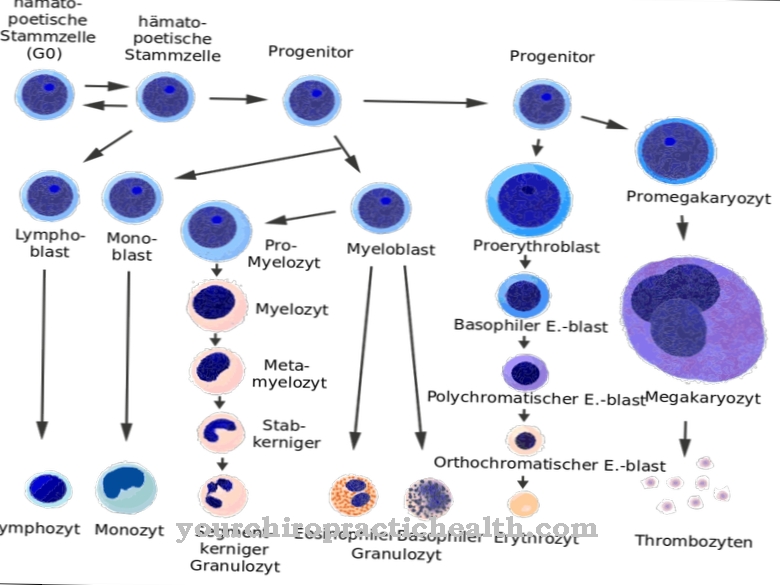The Bone marrow is not just a substance that has a very decisive, even vital, function in the organism. Many people consider the bone marrow to be a delicacy that is rich in energy, especially fat. In addition, diseases of the bone marrow have significant health consequences.
What is bone marrow?
Behind the somewhat complicated-sounding name medulla osseum that hides Bone marrow, which is initially classified as red, white or white bone marrow due to its optical properties.
When looking at the bone marrow under the microscope, a dense, cell-rich structure is revealed, which lines the inner cavity of the bone.
If the total mass of the bone marrow were to be combined and related to the remaining body weight, the result would be approximately 5 to 6% bone marrow. The bone marrow occurs mainly in the bones with a larger cross section.
Anatomy & structure
When sawing through a "marrow bone", for example the humerus or thigh bone, both solid and soft components would fall into the eye. The complex solid elements in Bone marrow belong the so-called cancellous trabeculae, within which the bone marrow is embedded.
From this point of view, the bone marrow is known as a spongy substance that consists primarily of connective tissue. In general, thousands of small blood vessels and epithelial and connective tissue cells are embedded in bone marrow regardless of its color. In addition, fat cells and platelets as well as immature levels of leukocytes and erythrocytes are integrated in the bone marrow.
In the white bone marrow, a proportion of tissue water predominates, which is in a gel-like state. Lymph vessels are absent from the bone marrow. Not all forms of bone marrow appear in every marrow bone.
Functions & tasks
In the anatomical studies of humans different proportions of Bone marrow found in both tubular and flat bones. This mainly affects the roof of the skull and the sternum as well as the rib bones.
One of the primary tasks of the bone marrow is the production of blood cells and platelets. The bone marrow is a place in the body in which not yet mature erythrocytes and leukocytes as well as platelets are located before they are flushed out into the blood fluid at a certain level.
These stages of maturation that take place in the bone marrow are referred to in medicine as erythrocytosis, thrombocytosis and leukocytosis and are controlled by specific hormones. The bone marrow also contains the so-called original or stem cells for the solid components of the blood.
In the course of life, the amount of bone marrow decreases, so it is necessary to transfer suitable stem cells in the form of bone marrow from other people. In this context, terms such as cord blood and bone marrow donation are popular areas of knowledge. These interventions can increase the chances for patients in whom the formation of the cells contained in the blood is impaired by illness or massive blood loss.
Diseases
Blood is life - red blood cells are involved in breathing, white blood cells and platelets in the body's immune system. If these B components are missing, this can lead to death.
Diseases on Bone marrow occur more frequently than is widely assumed. The bone marrow is extremely sensitive and can be damaged by hereditary or environmental influences. Typical diseases of the bone marrow that are accompanied by insufficient or absent blood formation are tumors in the bone marrow or water retention.
Intensive diseases such as leukemia (overproduction of leukocytes), myelodysplastic syndrome (myeloblasts are immature precursors of leukocytes that only occur in the bone marrow), neuroblastoma and the consequences of radioactive radiation are widely known due to the stimulation of bone marrow donation. This damages the genetic information of the stem cells in the bone marrow and the marrow in its physiology.
In addition, diseases that absolutely require treatment in the bone marrow are osteomyelitis (inflammatory processes in the bone) and leukopenia (too few leukocytes) and anemia (too few erythrocytes). An undersupply of the organism with the blood platelets relevant for clotting and wound healing can also be triggered by a disease in the bone marrow if the balance of blood cell formation is shifted or disturbed. This is also the case when there is aplasia (decrease in volume) in the bone marrow.
Typical & common diseases
- Osteomyelitis (inflammation of the bone marrow)
- Chronic myeloid leukemia
- Myelodysplastic Syndrome
- Plasmacytoma (multiple myeloma)

























.jpg)

.jpg)
